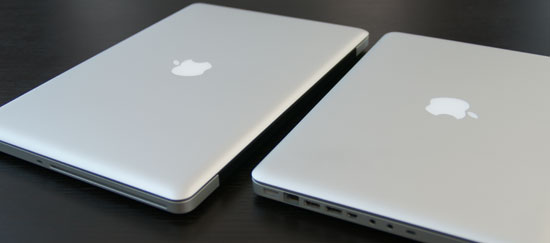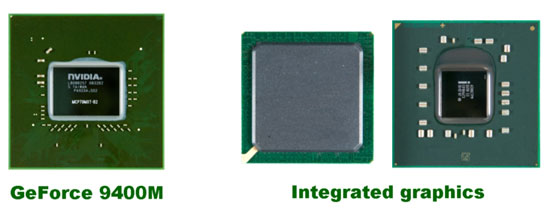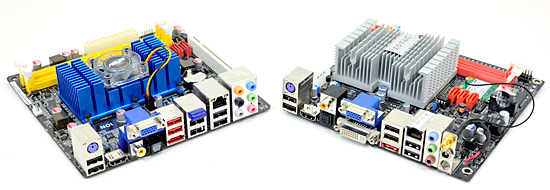NVIDIA's Bumpy Ride: A Q4 2009 Update
by Anand Lal Shimpi on October 14, 2009 12:00 AM EST- Posted in
- GPUs
Chipsets: One Day You're In and the Next, You're Out
Presently, NVIDIA’s chipset business is far from dead. They are in nearly every single Apple computer on the market, not to mention countless other OEMs. I’m not sure how much money NVIDIA is making from these chipsets, but they are selling.

NVIDIA won Apple's chipset business, Intel was not happy
Long term I don’t see much of a future for NVIDIA’s chipset business. NVIDIA said that they have no interest in pursuing an LGA-1156 chipset given Intel’s legal threats. Even if NVIDIA had a license to produce DMI chipsets, I’m not sure it makes sense.

NVIDIA's Advantage: A single chip GeForce 9400M instead of a dated Intel solution
Once the ‘dales hit, every single mainstream CPU from Intel is going to come with graphics on-package. Go out one more generation and Sandy Bridge brings the graphics on-die. AMD is doing the same thing starting in 2012.
It’s taken longer than expected, but there’s honestly no need for a third party chipset maker anymore. Most of the performance differentiation in chipsets has been moved onto the CPU die anyway, all that’s left are SATA, USB, and a bunch of validation that no one likes doing. NVIDIA is much better off building a discrete GeForce 9400M GPU at low cost and selling that. There’s much less headache involved with selling discrete GPUs than selling chipsets, plus graphics is NVIDIA’s only value add when it comes to chipsets - everyone knows how to integrate a USB controller by now. I’d say the same about SATA but AMD still has some AHCI silliness that it needs to sort out.
NVIDIA committed to supporting existing products in the channel and continues to poke fun at AMD with lines like this:
“On AMD platforms, we continue to sell a higher quantity of chipsets than AMD itself. MCP61-based platforms continue to be extremely well positioned in the entry CPU segments where AMD CPUs are most competitive vs. Intel”
As successful as NVIDIA’s AMD chipsets are today, AMD is telling us that nearly all OEM designs going forward use AMD chipsets. Again, NVIDIA’s chipset business is quite healthy today, but I don’t see much of a future in it - not that it’s a bad thing.
The only reason NVIDIA’s chipset business has lasted this long is because AMD and Intel couldn’t get their houses in order quickly enough. AMD is finally there and Intel is getting there, although it remains to be seen how well the next-generation of Atom platforms will work in practice.

A pair of Ion motherboards we reviewed
The main reason Ion got traction in the press was because it could play Blu-ray content. If Intel had done the right thing from the start and paired Atom with a decent chipset, NVIDIA would never have had the niche for Ion to fit into.










106 Comments
View All Comments
Scali - Sunday, October 18, 2009 - link
If you sort by percentage change:http://store.steampowered.com/hwsurvey/videocard/?...">http://store.steampowered.com/hwsurvey/videocard/?...
Then add up all the increases from nVidia, you get to +1.42%.
Do the same for all ATi parts, and you get +1.06%.
(Obviously you can't do a direct comparison of the 260 to the entire 4800-series, as the 260 is just a single part. You would then ignore various other parts that also compete with the 4800 series, such as the 9800GTX).
shin0bi272 - Thursday, October 15, 2009 - link
It does MIMD processing and parallel kernel processing.true 32bit floating point processing in 1 clock (previous only did 24bit and emulated 32bit) and is now using the IEE754-2008 standard instead of the 1984 standard. so its 64bit or double precision performance is 1/2 that of the single precision now, while their previous was 1/8th as fast and AMD's is 1/5th.
With the addition of a second dispatch unit they are able to send special functions to the sfu at the same time they are sending gp shaders... meaning they no longer have to take up the entire SM (group of shader cores acting as a unit from what I can gather) to do an interpolation calculation.
They added an actual cache hierarchy instead of the software managed memory in the gt200 series which eliminates a large problem they were having which was shared memory size an that means increased performance.
Nvidia says that its switching between cuda and gpu is now 10x faster which means that physx performance will increase dramatically annnnnd it supports parallel transfers to the cpu vs serial in previous cards... so multiple cpu cores and multiple connections to the gpu means much better performance.
Nvidia claims they learned their lesson on moving to different die sizes and guessing on their pricing. They were really pushing the new die with the old 5800fx chip and they got beat bad by ati... conversely they took their time with the gt200's and ended up pricing them according to what they thought the ati 48xx would be and ended up overshooting by a LOT. Whether or not they are full of it remains to be seen here but hopefully we can expect a 450-500 dollar gt300 flagship card early in 2010. The biggest issue is that ati already has boards in production and 1600 simd (single instruction multiple data) cores vs 512 mimd cores in the fermi. The ati card also runs at 850mhz vs probably 650mhz in the nvidia. We will just have to wait and see the benchmarks I guess.
Plus add in the horrible state of the economy (which is only going to get worse when congress goes to do the budget for 2011 in march), the falling value of the dollar, the continuing increase of the unemployment rate, the impending deficit/debt issues, the oil producing countries talking of dumping the dollar, the UN wanting to dump the dollar as the international reserve currency, etc., etc. and Nvidia cutting back on production might not be such a bad idea. If the economy collapses again once the government has to raise the interest rates and taxes to pay for their spending then AMD might be hurting with so much product sitting on the shelves collecting dust.
(fermi data from http://anandtech.com/video/showdoc.aspx?i=3651&...">http://anandtech.com/video/showdoc.aspx?i=3651&...
Scali - Thursday, October 15, 2009 - link
You should put the 1600 SIMD vs 512 SIMD in the proper perspective though...Last generation it was 800 SIMD (HD4870/HD4890) vs 240 SIMD (GTX280/GTX285).
With 1600 vs 512, the ratio actually improves in nVidia's favour, going from 3.33:1 to 3.1:1.
shin0bi272 - Friday, October 16, 2009 - link
Ahh thats true I didnt think about that. With all the other improvements and the move to ddr5 it should be a great card.Zool - Thursday, October 15, 2009 - link
In the worst case scenariou ati has 320 ALUs and in the best case 1600.Nvidia has in best and worst case same 512 ALUs. And the nvidia shaders runs at much higher frequency. Let we say double altough for gt300 the 1700 Mhz shaders wont be too realistic.
So actualy in the worst case scenario the gt300 has more than 3 times the ALUs than the radeon. In the best case scenario radeon has around 60% advantage over nvidia (with the unrealistic shader clocks).
And in the end some instructions may take more clock cycles on the GT300 some on the radeon 5800.
So your perspective is way off.
Scali - Thursday, October 15, 2009 - link
My perspective was purely that the gap in number of SIMDs between AMD becomes smaller with this generation, not larger. It's spot on, as there simply ARE 800 and 240 units in the respective parts I mentioned.Now you can go and argue about clockspeeds and best case/worst case, but that's not going to much good since we don't know any of that information on Fermi. We'll just have to wait for some actual benchmarks.
Zool - Friday, October 16, 2009 - link
The message of my reply was that just plain shader vs shader conclusions are very inaccurate and mean usualy nothing.Scali - Friday, October 16, 2009 - link
I never claimed otherwise. I just pointed out that this particular ratio would move more towards nVidia, as the post I was replying to appeared to assume the opposite, speaking out a concern on the large difference in raw numbers.Zool - Thursday, October 15, 2009 - link
The gt240 doesnt seem to be much better if they follow the gt220 price scenario.link http://translate.google.com/translate?prev=hp&...">http://translate.google.com/translate?p...sl=zh-CN...
The core/shader clocks are prety low for 40nm. Lets hope that gt300 will run on higher than that.
shotage - Thursday, October 15, 2009 - link
Just read this article and found it pretty ensightful, it's focus is the shift in microarchitecture of the GPU - primary focus is on Nvidia and their upcoming Fermi chipset. Very good technical read for those that are interested:http://www.realworldtech.com/page.cfm?ArticleID=RW...">http://www.realworldtech.com/page.cfm?ArticleID=RW...